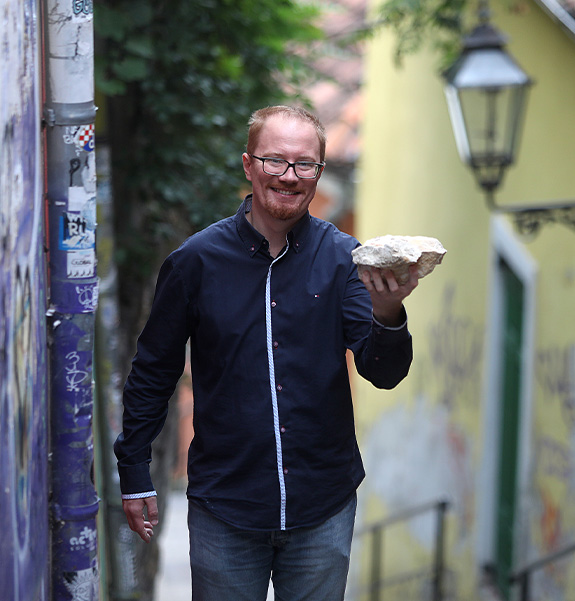FOREWORD
To make things worse, on the morning of the earthquake snow fell. A late snow, completely unexpected for late March. In the Upper Town, among the people who rushed frantically out of their homes (still in fear of the coronavirus, which had forced people in Zagreb and the rest of Croatia into a collective quarantine), there was a couple with a several months old baby. The baby squealed with joy, laughing at the situation it found itself in. It was the baby’s first snowfall, the first earthquake and the first epidemic. I couldn’t but admire the stoicism and ease with which this tiny human being accepted the reality. Some might say that it was easy for the baby, that it didn’t understand the long-term consequences of natural disasters and didn’t need to cope with them. To a city center girl, a mere snowfall was enough to curse all the gods for having to walk around the city with damp feet; to a worker, the lockdown measures were devastating because they had taken away the ability to earn for his family; and to anyone whose home was severely damaged by the earthquake, the last few months were a survival challenge – from asking for hot water from friends to endless waiting for damage repair services and coming up with quite a lot of money for all those unexpected repairs. Still, a small child doesn’t realize the gravity of those tragedies and, if I may be so bold, brings them down to the right scale. If we look at trauma as something that happened without our intent and control, but also as something to draw new experiences and insights from, maybe we can accept living in the moment, a life without a past and future. Maybe then, for a short while, we can understand the baby’s wisdom.
A press photo can be a guide to that wisdom. Its value is never purely documentary or informational. By extracting a small piece of reality, it brings us back to the time and place of its creation. It allows us to relive an event, to recall our or (if we were not the participants) someone else’s emotions while it was happening. After the Zagreb earthquake, Jutarnji list photojournalists rushed around the city, capturing its immediate and long-term consequences. They turned a natural disaster into a dynamic mosaic of events. With the passing of time, all traces of the earthquake will disappear, its witnesses will die, but these photographic testimonies by Boris Kovačev, Goran Mehkek, Damjan Tadić, Marko Todorov, Neja Markičević, Bruno Konjević, Ivana Nobilo, Srđan Vrančić, Damir Krajač, Davor Pongračić, Željko Puhovski, Darko Tomaš, Ranko Šuvar, Ronald Goršić and Tomislav Krišto will remain as vibrant footprints of an enormous life – the life of a city. Without being pretentious, I would call photojournalists artists, because by capturing current events they create photographs that are much more esthetically interesting than applied photography, and at times much more esthetically potent than contemporary photography with purely artistic aspirations, which is often reduced to a play of forms and effects.
On the photos that are shown here, we see chaos, which, perhaps paradoxically, turns into a fully harmonious choreography.
There are crumbled Lower Town facades and cars crushed under the rubble, firefighters and alpinists climbing the roofs to remove toppled chimneys, the mayor inspecting damaged buildings, scared seniors wrapped in blankets on the cold morning of the earthquake, pregnant women evacuated from a damaged old hospital, removal of the cracked marzipan-like spire of the cathedral (the spire itself built after a devastating earthquake, 140 years ago) and the removal of a dome from Ilica Street (with many other Lower Town domes falling victims to this earthquake), as well as touching street artist messages, which can be seen messages of support to the city and its inhabitants, intentional or not.
The city is reshuffled and its face has changed. But all those changes are, in fact, minimal. Every morning I am awakened in the Upper Town by the construction works on the surrounding buildings. Zagreb has become a construction site. Its cathedral towers are a bit shorter, several domes and ornaments have been taken down, but life is getting back to its normal course. And this tectonic tantrum of the Earth will soon be forgotten, at least until the next earthquake. The creations of the photojournalists who made their way through our city in those strangely cold spring mornings, avoiding the fallen pieces of buildings and road sections that were fenced for safety reasons, to bring these photos, will remain a dynamic memento of those crazy days in 2020.
And the city’s life will go on, with or without chipped pieces of facades, spires or domes. Because a city is a gigantic monster with countless heads (as Gogol and Poe once wrote), looking at all the minor troubles and major disasters, all past traumas and future uncertainties, with indifference, goofiness, but also with joy, like a little baby.
Feđa Gavrilović

© Ranko Šuvar
